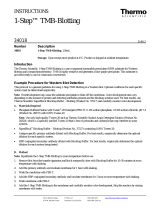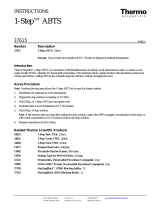Page is loading ...

INSTRUCTIONS
Pierce Biotechnology
PO Box 117
(815) 968-0747
www.thermoscientific.com/pierce
3747 N. Meridian Road
Rockford, lL 61105 USA
(815) 968-7316 fax
Number Description
15168 SuperSignal West HisProbe Kit, sufficient for 65 mini-blots or 5000cm2 of membrane
Kit Contents:
HisProbe-HRP, 2mg
SuperSignal West Pico Luminol/Enhancer Solution, 250mL
SuperSignal West Pico Stable Peroxide Solution, 250mL
Blocker™ BSA in TBS (10X), 125mL
BupH™ Tris Buffered Saline Packs, 10 each
Note: The BupH™ Tris Buffered Saline Packs are located under the corrugated cardboard insert.
To access the packs, remove the insert.
Surfact-Amps® 20, 6 × 10mL ampules
Storage: Upon receipt store HisProbe-HRP and Blocker BSA in TBS (10X) and Surfact-Amps 20 at
4°C. All other components may be stored at room temperature. Kit is shipped at ambient temperature.
Introduction
The HisProbe-HRP Technology uses a tridentate metal chelating group capable of binding divalent nickel. The interaction
between divalent nickel and histidines is commonly used to purify polyhistidine-tagged fusion proteins.1-6 Nickel ions can
also be chelated to different ligands. The Thermo Scientific SuperSignal HisProbe Kit combines the HisProbe-HRP
Technology and the SuperSignal West Pico Chemiluminescent Substrate for polyhistidine-tagged fusion protein detection in
Western blotting applications.7-9 HisProbe-HRP is a nickel-activated derivative of horseradish peroxidase (HRP) that is
optimized for direct detection of recombinant polyhistidine-tagged fusion proteins. SuperSignal Substrate is an enhanced
chemiluminescent detection substrate for HRP. This combination of products produces maximum sensitivity that allows for
detection of low expressing clones while maintaining specificity.
A variety of polyhistidine-tagged proteins have been detected with this technology including those expressed in E. coli and
insect Sf9 cells. In comparative experiments with another nickel-activated HRP probe that used a tetradentate chelating
group, HisProbe-HRP exhibited higher specificity to polyhistidine-tagged recombinant proteins and lower background from
non-polyhistidine-tagged proteins.
Furthermore, many monoclonal anti-His antibodies require a specific location of the polyhistidine tag (N- or C-terminus),
primary and secondary antibody incubations, and the presence of specific adjacent amino acid sequences. HisProbe-HRP
requires a simple one-step probe incubation and detects polyhistidine tags independent of location and adjacent sequences.
Detection of polyhistidine-tagged protein by the HisProbe-HRP is, therefore, more versatile than antibody-based detection.
0711.4
15168
SuperSignal® West HisProbe™ Kit

Pierce Biotechnology
PO Box 117
(815) 968-0747
www.thermoscientific.com/pierce
3747 N. Meridian Road
Rockford, lL 61105 USA
(815) 968-7316 fax
2
Material Preparation
Tris Buffered Saline
Tween®-20 Detergent
(TBST)
Dissolve contents of one BupH Tris Buffered Saline Pack in 500mL of ultrapure water and
then add 2.5mL of Surfact-Amps 20. Final composition will be 25mM Tris, 0.15M NaCl, pH
7.6, 0.05% Tween®-20 Detergent.
BSA/TBST
Dilute one volume of Blocker BSA in TBS (10X) into three volumes of TBST. Final
composition will be 25mg bovine serum albumin/mL in TBST.
Note: BSA/TBST can be used for blocking at 10mg BSA/mL TBST if blocking is performed
overnight at 4°C.
HisProbe-HRP Working
Solution Reconstitute vial of HisProbe-HRP with 0.5mL of ultrapure water. Store unused portion at 4°C
for short-term storage or in single-use aliquots at -20°C for long-term storage. Prepare working
solution by diluting 1:5000 in TBST.
SuperSignal West Pico
Substrate Working
Solution
Mix equal volumes of Luminol/Enhancer Solution with Stable Peroxide Solution.
Recommended volume is 0.1mL/cm2 of blot surface.
Note: The Substrate Working Solution is stable for 8 hours at room temperature. Exposure to
the sun or any other intense light can harm the Working Solution. For best results keep the
Working Solution in an amber bottle and avoid prolonged exposure to any intense light. Short-
term exposure to typical laboratory lighting will not harm the Working Solution.
Procedure for Detection of Polyhistidine-Tagged Fusion Proteins
Note: Volumes indicated below are for one 7.5 × 10cm2 blot. Volumes can be adjusted for staining multiple blots or for
different-sized blots.
1. Transfer protein from gel to a nitrocellulose membrane.
Note: Although other membranes can be used, optimization may be required.
2. Place the membrane in a tray and block with 10mL of BSA/TBST for 1 hour at room temperature with shaking.
3. Wash the membrane twice with 15mL of TBST for 10 minutes each.
4. Incubate blot with 10mL of HisProbe-HRP Working Solution for 1 hour with shaking.
5. Wash the membrane four times with 15mL of TBST for 10 minutes each.
6. Incubate blot with 7.5mL of SuperSignal West Pico Substrate Working Solution for 5 minutes.
7. Remove blot from the Substrate Working Solution and place in a membrane sheet protector. Use an absorbent tissue to
remove excess liquid and to carefully press out any bubbles from between the blot and the surface of the membrane
protector.
8. Place the protected membrane in a film cassette with the protein side facing up. Turn off all lights except those
appropriate for film exposure (e.g., a red safelight).
Note: Film must remain dry during exposure. For optimal results, perform the following precautions:
• Make sure excess substrate is removed from the membrane and the membrane protector.
• Use gloves during the entire film-handling process.
• Never place a blot on developed film. There may be chemicals on the film that will reduce signal.
9. Carefully place a piece of film on top of the membrane. A recommended first exposure time is 60 seconds; however,
exposure time can be varied to achieve optimal results. Place the membrane protector containing the blot against film
and expose.
10. Develop the film.
Note: The blot can be re-exposed to film for various times as needed.

Pierce Biotechnology
PO Box 117
(815) 968-0747
www.thermoscientific.com/pierce
3747 N. Meridian Road
Rockford, lL 61105 USA
(815) 968-7316 fax
3
Related Thermo Scientific Products
28376 BupH Tris Buffered Saline Packs, 40 packs
28320 Surfact-Amps 20 (10% Tween®-20 Detergent), 6 × 10mL
37520 Blocker BSA in TBS (10X), 125mL
15165 HisProbe-HRP, 2mg
34090 CL-XPosure™ Film, 5” × 7” sheets, 100 sheets/pkg
21065 Pierce® Background Eliminator Kit, for eliminating background from X-ray film
34080 SuperSignal West Pico Chemiluminescent Substrate, 500mL
88018 Nitrocellulose Membrane, 0.45µm, 33cm × 3m, 1 roll
77010 Nitrocellulose Membrane, 0.45µm, 8 × 12cm, 25/pkg
88025 Nitrocellulose Membrane, 0.45µm, 8 × 8cm, 15/pkg
88600 Western Blotting Filter Paper, 8cm × 10.5cm, 100 sheets
24580 Pierce Reversible Protein Stain Kit for Nitrocellulose Membranes
24585 Pierce Reversible Protein Stain Kit for PVDF Membranes
Cited References
1. Jin, L., et al. (1995). Use of a N,N-bis[carboxymethyl]lysine-modified peroxidase in immunoassays. Anal Biochem 229:54-60.
2. McMahan, S. and Burgess, R.R. (1996). Single-step synthesis and characterization of biotinylated nitrilotriacetic acid, a unique reagent for the
detection of histidine-tagged proteins immobilized on nitrocellulose. Anal Biochem 236:101-6.
3. Botting, C.H. and Randall, R. E. (1995). Reporter enzyme-nitrilotriacetic acid-nickel conjugates: Reagents for detecting histidine-tagged proteins.
Biotechniques 19(3):362.
4. Porath, J. (1992). Immobilized metal ion affinity chromatography. Protein Expression and Purification 3:263-81.
5. Belew, M. and Porath, J. (1990). Immobilized metal ion affinity chromatography: Effect of solute structure, ligand density, and salt concentration on
the retention of peptides. J Chrom 516:333-54.
6. Hemdan, E., et al. (1989). Surface topography of histidine residues: A facile probe by immobilized metal ion affinity chromatography. PNAS 86:1811-
5.
7. L.L. Syklauk, et al. (1997). Nickel chelated to a novel tridentate chelating group binds histidine-tagged fusion proteins: Applications of a nickel-
activated horseradish peroxidase probe and a nickel-activated microtiter plate for assays. Abstract No. 3204, Experimental Biology. New Orleans, LA.
April 6-9, 1997.
8. Chu, R., et al. (1997). SuperSignal HisProbe Western Blotting Kit: Rapid detection of polyhistidine-tagged fusion protein with enhanced specificity,
versatility, and high sensitivity. Previews, 1(3) (Pierce Chemical Co.).
9. Klenk, D., et al. (1997). Detection of polyhistidine-tagged proteins with SuperSignal HisProbe Western Blotting Kit: One-step incubation, high
specificity and sensitivity. 12th International Symposium on Affinity Interactions: Fundamentals and Applications of Biomolecular Recognition.
Kalmar, Sweden. June 15-19, 1997.
Tween is a trademark of Croda International Plc.
This product (“Product”) is warranted to operate or perform substantially in conformance with published Product specifications in effect at the time of sale,
as set forth in the Product documentation, specifications and/or accompanying package inserts (“Documentation”) and to be free from defects in material and
workmanship. Unless otherwise expressly authorized in writing, Products are supplied for research use only. No claim of suitability for use in applications
regulated by FDA is made. The warranty provided herein is valid only when used by properly trained individuals. Unless otherwise stated in the
Documentation, this warranty is limited to one year from date of shipment when the Product is subjected to normal, proper and intended usage. This
warranty does not extend to anyone other than the original purchaser of the Product (“Buyer”).
No other warranties, express or implied, are granted, including without limitation, implied warranties of merchantability, fitness for any particular
purpose, or non infringement. Buyer’s exclusive remedy for non-conforming Products during the warranty period is limited to replacement of or
refund for the non-conforming Product(s).
There is no obligation to replace Products as the result of (i) accident, disaster or event of force majeure, (ii) misuse, fault or negligence of or by Buyer, (iii)
use of the Products in a manner for which they were not designed, or (iv) improper storage and handling of the Products.
Current product instructions are available at www.thermoscientific.com/pierce. For a faxed copy, call 800-874-3723 or contact your local distributor.
© 2012 Thermo Fisher Scientific Inc. All rights reserved. Unless otherwise indicated, all trademarks are property of Thermo Fisher Scientific Inc. and its
subsidiaries. Printed in the USA.
/









